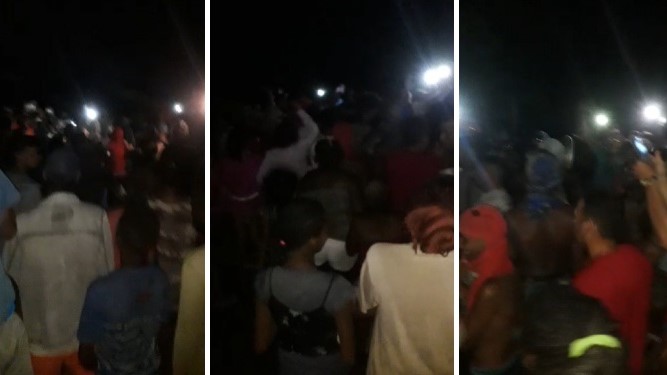In a few hours it will be 28 years since the social uprising in Havana known today as "El Maleconazo." These kinds of spontaneous protests have become a regular phenomenon in Cuba, to the point that it is no longer extraordinary for there to be, every night, especially in towns suffering protracted blackouts, people banging pots and pans and shouting anti-regime slogans.
The kind of event seen on August 5, 1994, long put down by the regime to the euphemistically-dubbed "Special Period," and alleged incitements to emigrate by Washington, are now daily occurrences, without any reference to them in the official media.
The historical circumstances are similar, but not identical: in addition to a serious shortage of food, medicine and basic necessities, today Cuba is suffering the worst blackouts since the 1990s.
Back then Fidel Castro sought to let the pressure cooker vent by allowing everyone who wanted to flee by sea to do so. The micro outbursts in recent weeks are occurring as Cuba is witnessing its greatest exodus in more than half a century, with figures even higher than the Raft Crisis following the Maleconazo, and even its historic predecessor, the Mariel Boatlift.
The protests these days are for multiple reasons, though in most cases they erupt amidst demands for a solution to the blackouts. In addition to this demand there are those of the relatives of 11J prisoners calling for their release, mothers with children who require decent housing, and with them, cries of "Libertad", "Díaz-Canel S.O.B.," and "Abajo la dictatorship" (Down with the dictatorship), connecting recent events with the repudiation of the regime made explicit a year ago in dozens of Cuban cities.
The protests are hard to map today. The demonstration in Los Palacios, Pinar del Río, on July 14 was followed by protests in more than three dozen cities and towns in at least 13 provinces, according to citizen reports verified by independent media and activists on the ground.
According to the DeFacto verification project by the digital medium El Toque, the first confirmed protest of the current energy crisis took place at the Universidad Ignacio Agramonte de Camagüey, where students shouted a slogan that has been heard elsewhere: "Ponga la corriente, pinga!" (Give us electricity, you prick!)
According to this analysis, since then there have been 25 verified protests, gaining steam with the passing of the days. The nights of August 1 and 2 saw the greatest number of simultaneous demonstrations take place.
DeFacto reported that the day after the protest at the Universidad de Camagüey residents of Manzanillo emerged to demonstrate after more than 12 hours without electricity.
In mid-July the situation of social tension intensified, as dozens of people in Baracoa (Guantánamo) demonstrated on the quay there, on July 15. On the 19th the situation repeated itself in the town of Rosalía-Constancia, in the municipality of Abreus (Cienfuegos), on the 22nd in Colón (Matanzas), in Caibarién (Villa Clara), Reparto Lili, (Sagua la Grande, Villa Clara), and in Jagüey Grande (Matanzas).
On the night of that same day, the offices of the Tapaste Electric Company (Mayabeque) were set on fire by unknown parties.
On the 23rd Granma joined the list, when residents of the La Marina neighborhood, in Campechuela, protested publicly. Then on the 30th there was general unrest that included the Central Australia, in Jagüey Grande; the town of Covadonga, in Aguada de Pasajeros, Cienfuegos (where, according to DeFacto, the Arcoíris MLC store was pelted with rocks); and Bauta, in Artemisa.
The next night Nuevitas, in Camagüey, also took to the streets, and on August 1 it was the Reparto Tulipán and Caunao del Sur, in Cienfuegos; El Tibol, in San José de las Lajas, Mayabeque; Mabay, in Bayamo, Granma; Antilla, north of Holguín; Trinidad, in Sancti Spíritus; and Herradura, in Consolación del Sur, Pinar del Río.
On August 1, dozens of residents of Vista Hermosa, in Santiago de Cuba, hit the streets to protest, in broad daylight, after suffering constant blackouts, and six relatives of 11J political prisoners demonstrated in front of the Havana Cathedral, demanding the release of their family members.
On Tuesday 2, dozens of women with children shut down transit on part of the National Highway near the El Comodoro camp/shelter, in the Calvario-Fraternidad Popular Council (Arroyo Naranjo, Havana) demanding Miguel Díaz-Canel's presence.
When we add to this the dozens of anti-regime posters appearing in public places all across Cuba, the fires allegedly affecting state entities, plus the dengue epidemic, which continues to spread, the situation has reached unimaginable extremes.
This time, does the regime have an answer when the only solution to this social crisis is to democratize the country and hand over power? Cubans now hold the outcome in their hands... and everything seems to indicate that they have now realized this.
